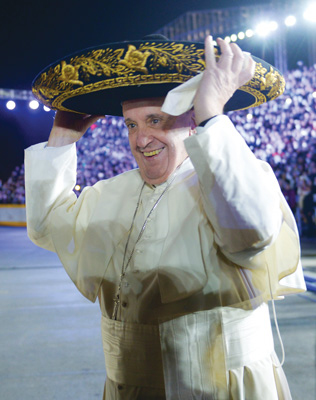
In a perfectly pitched appeal to Mexico’s heart and soul, Pope Francis has spent his visit since Saturday seeking to bolster the Church for mission, while urging Mexicans to seek solutions to their many challenges by drinking deep from the wells of their own traditions.
A major part of his message has been communicated in his actions: leaving the capital each morning for far-flung places never visited by previous popes, before returning each night to the nunciature in Mexico City, symbolically connecting the center with the periphery from where, he believes, true renewal comes.
This, too, has been his verbal message. In powerful addresses and homilies, he has urged Mexican Catholics to learn from the Virgin of Guadalupe’s encounter with the Indian seer Juan Diego 10 years after the Spanish conquest – an event that sparked the largest mass conversion in human history.
“Above all, la Virgen Morenita teaches us that the only power capable of conquering the hearts of men and women is the tenderness of God,” the pope told the bishops on Saturday.
Pope Francis has been holding up the Guadalupe story as the key to a Church that is as close to the poor – pastoral, missionary and merciful; a Church that values the country’s native heritage, and that rather than riding roughshod over indigenous culture, builds it up, creating a new civilization born of the Gospel seed planted in the native soul.
“On that morning,” said Pope Francis at the Basilica of Guadalupe on Saturday, “God awakened the hope of his son Juan, and the hope of his People. On that morning, God roused the hope of the little ones, of the suffering, of those displaced or rejected, of all who feel they have no worthy place in these lands.”
The credibility of this depends on embodying that mercy, he told the bishops. “Only a Church able to shelter the faces of men and women who knock on her doors will be able to speak to them of God.”
In Chiapas, Mexico’s least Catholic and most indigenous state on the southern border with Guatemala, that pastoral closeness was typified by the late Bishop Samuel Ruiz, who for 40 years led the Church in the region, building up the leadership of the Mayan peoples and seeking to “inculturate” the Gospel in face of hostility from some of his fellow bishops, and at times, suspicion from the Vatican.
Mass in Native Languages
Pope Francis signaled a distinct shift in Rome’s views by praying for five minutes at the tomb of Bishop Ruiz, and authorizing the use of native languages in liturgies.
At a joyful, colorful Mass celebrated by native clergy yesterday, he told the Tzotzil, Tzeltal and Cho’ol-speaking peoples of the south that they should be valued and integrated. “Some have considered your values, culture and traditions to be inferior,” he told the congregation. “Others, intoxicated by power, money and market trends, have stolen your lands or contaminated them.”

Another pastor who exemplified that closeness to Mexico’s Indian poor was the 16th-century bishop of Michoacán, known as “Tata Vasco,” and the “Spaniard who became an Indian.” Using his crozier and chalice at the Feb. 16 Mass in Morelia, to the west of Mexico City, Pope Francis drew an analogy between the oppression of the native peoples under the Spanish at Tata Vasco’s time and the domination of the drug cartels in the state today.
In both cases, he said, the temptation is one of resignation. But the suffering that Tata Vasco was faced with “moved his faith, moved his life, moved his compassion, and led him to carry out different projects that relieved this paralyzing and unjust reality.”
In starting his journey on the margins of the south and finishing on the northern border of Ciudad Juárez, Pope Francis is symbolically recreating the journey made by hundreds of thousands of Central Americans in search of a new life in the United States.
Aware that immigration is the great issue of our time, Pope Francis went to Juárez to be among people who live the effects of life on the border, and to pray just feet from the Rio Bravo on a specially erected platform.
The cross that has been placed at the top of the platform bears an image of the Holy Family fleeing into Egypt.
“Your efforts will not be in vain when your dioceses show care by pouring balm on the injured feet of those who walk through your territories,” he told the bishops just one day after arriving in Mexico.
Austen Ivereigh is a writer, journalist, broadcaster and author of “The Great Reformer: Francis and the Making of a Radical Pope” (now out in Picador paperback with a new, updated epilogue).
Related
Follow the pope’s apostolic visit to Mexico, Feb. 12-17, by clicking “Pope In Mexico.” For live TV, coverage, go to http://netny.tv/.
